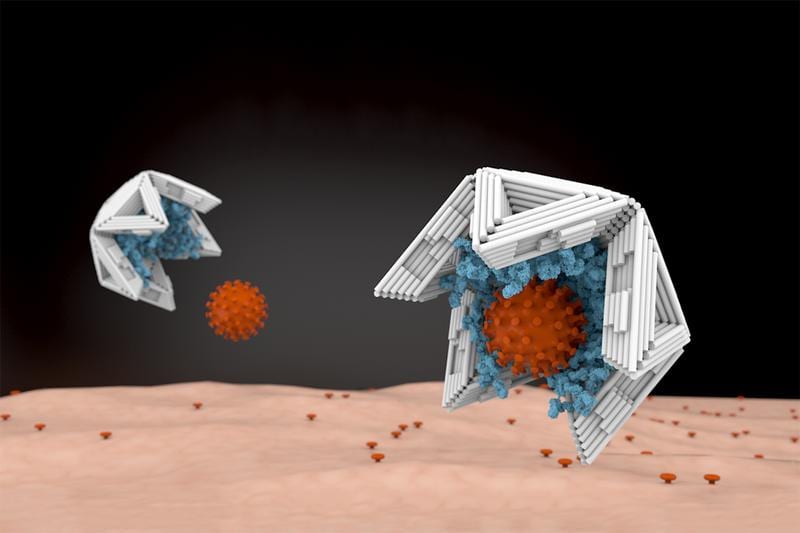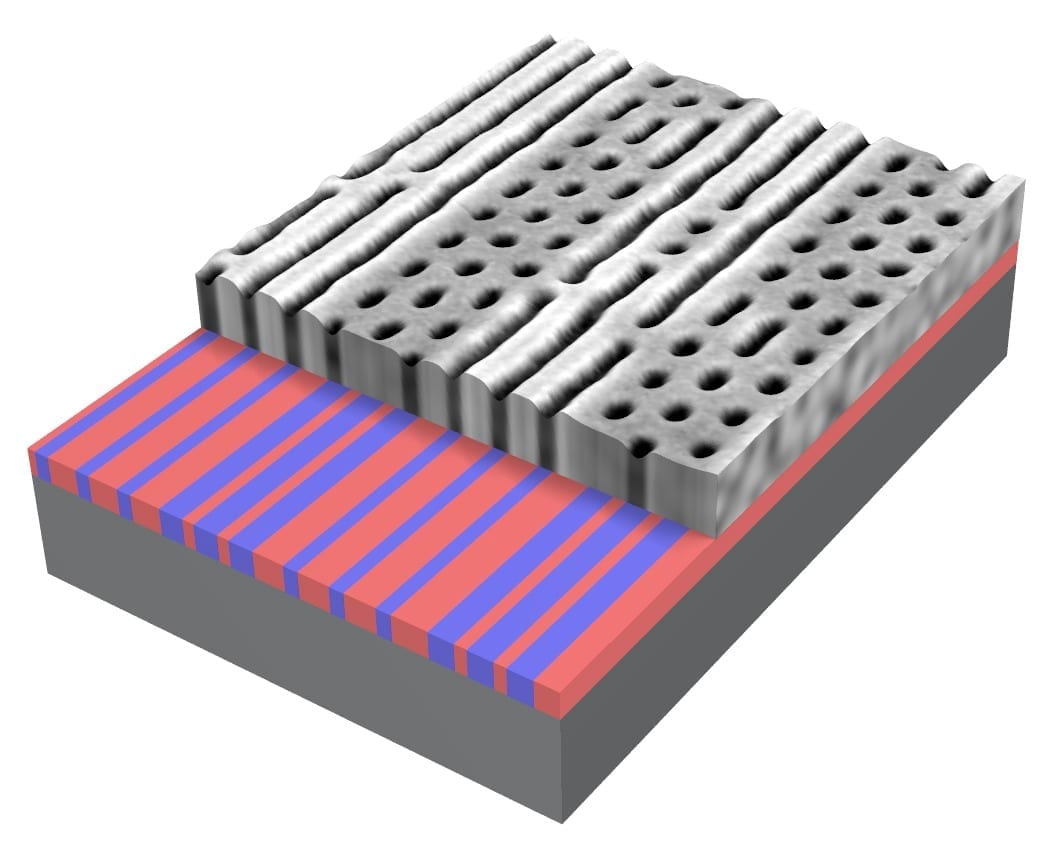
Lined on the inside with virus-binding molecules, nano shells made of DNA material bind viruses tightly and thus render them harmless.
Image: Elena-Marie Willner / DietzLab
Hollow nano-objects made of DNA could trap viruses and render them harmless
To date, there are no effective antidotes against most virus infections. An interdisciplinary research team at the Technical University of Munich (TUM) has now developed a new approach: they engulf and neutralize viruses with nano-capsules tailored from genetic material using the DNA origami method. The strategy has already been tested against hepatitis and adeno-associated viruses in cell cultures. It may also prove successful against corona viruses.
There are antibiotics against dangerous bacteria, but few antidotes to treat acute viral infections. Some infections can be prevented by vaccination but developing new vaccines is a long and laborious process.
Now an interdisciplinary research team from the Technical University of Munich, the Helmholtz Zentrum München and the Brandeis University (USA) is proposing a novel strategy for the treatment of acute viral infections: The team has developed nanostructures made of DNA, the substance that makes up our genetic material, that can trap viruses and render them harmless.
DNA nanostructures
Even before the new variant of the corona virus put the world on hold, Hendrik Dietz, Professor of Biomolecular Nanotechnology at the Physics Department of the Technical University of Munich, and his team were working on the construction of virus-sized objects that assemble themselves.
In 1962, the biologist Donald Caspar and the biophysicist Aaron Klug discovered the geometrical principles according to which the protein envelopes of viruses are built. Based on these geometric specifications, the team around Hendrik Dietz at the Technical University of Munich, supported by Seth Fraden and Michael Hagan from Brandeis University in the USA, developed a concept that made it possible to produce artificial hollow bodies the size of a virus.
In the summer of 2019, the team asked whether such hollow bodies could also be used as a kind of “virus trap”. If they were to be lined with virus-binding molecules on the inside, they should be able to bind viruses tightly and thus be able to take them out of circulation. For this, however, the hollow bodies would also have to have sufficiently large openings through which viruses can get into the shells.
“None of the objects that we had built using DNA origami technology at that time would have been able to engulf a whole virus – they were simply too small,” says Hendrik Dietz in retrospect. “Building stable hollow bodies of this size was a huge challenge.”
The kit for a virus trap
Starting from the basic geometric shape of the icosahedron, an object made up of 20 triangular surfaces, the team decided to build the hollow bodies for the virus trap from three-dimensional, triangular plates.
For the DNA plates to assemble into larger geometrical structures, the edges must be slightly beveled. The correct choice and positioning of binding points on the edges ensure that the panels self-assemble to the desired objects.
“In this way, we can now program the shape and size of the desired objects using the exact shape of the triangular plates,” says Hendrik Dietz. “We can now produce objects with up to 180 subunits and achieve yields of up to 95 percent. The route there was, however, quite rocky, with many iterations.”
Viruses are reliably blocked
By varying the binding points on the edges of the triangles, the team’s scientists can not only create closed hollow spheres, but also spheres with openings or half-shells. These can then be used as virus traps.
Original Article: The virus trap
More from: Technical University of Munich | Brandeis University
The Latest Updates from Bing News & Google News
Go deeper with Bing News on:
Virus trap
- Federal energy minister defends carbon capture technology after Alberta project scrapped
Canada’s energy minister is defending carbon capture and storage technology as both effective and affordable, after an Alberta power company walked away from a planned project and a study found that ...
- 3 Cheap and Easy Ways to Make a DIY Mosquito Trap
And because some species transmit human pathogens, including West Nile virus, malaria ... you can invest in a commercial mosquito trap or try one of these homemade weapons for outdoor mosquito ...
- 3 Cheap and Easy Ways to Make a DIY Mosquito Trap
Learn More › Itchy bites make mosquitoes a nuisance in any setting, but they’re especially aggravating when they violate your backyard. If you want to enjoy your yard without having to bathe in bug ...
- How To Take The Bite Out Of Mosquito Season
Stop mosquitoes from laying eggs in or near standing water. Once a week, empty and scrub, turn over, cover, or throw out items that hold water, such as tires, buckets, planters, toys, pet bowls, ...
- Best cloud antivirus of 2024
Keeping your business computing assets safe isn't always a straightforward task—luckily, that's where a reliable cloud antivirus can help out. These solutions allow you to set up a virtual ...
Go deeper with Google Headlines on:
Virus trap
[google_news title=”” keyword=”virus trap” num_posts=”5″ blurb_length=”0″ show_thumb=”left”]
Go deeper with Bing News on:
DNA nano-objects
- New DNA origami technique promises advances in medicine
A new technique in building DNA structures at a microscopic level has the potential to advance drug delivery and disease diagnosis, a study suggests. A team of scientists, from the universities of ...
- Study reveals differences in DNA folding between neurons and other brain cells, links them to cell functions
Researchers from Skoltech and their colleagues have investigated nerve cell regulation. Mounting knowledge of regulation mechanisms could enable a better understanding of how the healthy brain ...
- Protecting the Future with DNA Data Storage
From a coding perspective, this micro/nano technology practice dates ... Functional Artificial Objects The science of this DNA storage remains somewhat experimental and is very much an ongoing ...
- Structural DNA Nanotechnology
Written by the founder of the field, this is the first text of its kind, providing a definitive introduction to structural DNA nanotechnology. Readers will learn everything there is to know about the ...
- Structural DNA Nanotechnology
Written by the founder of the field, this is the first text of its kind, providing a definitive introduction to structural DNA nanotechnology. Readers will learn everything there is to know about the ...
Go deeper with Google Headlines on:
DNA nano-objects
[google_news title=”” keyword=”DNA nano-objects” num_posts=”5″ blurb_length=”0″ show_thumb=”left”]










